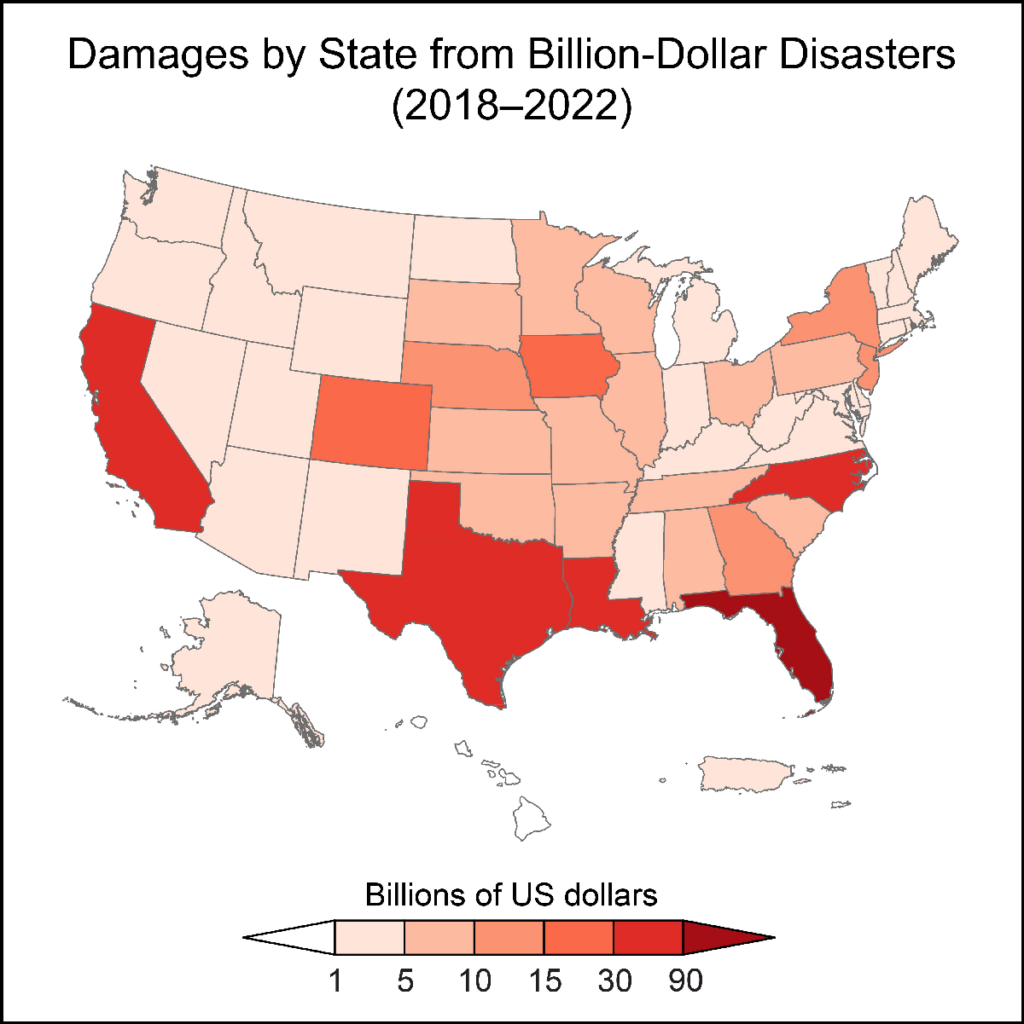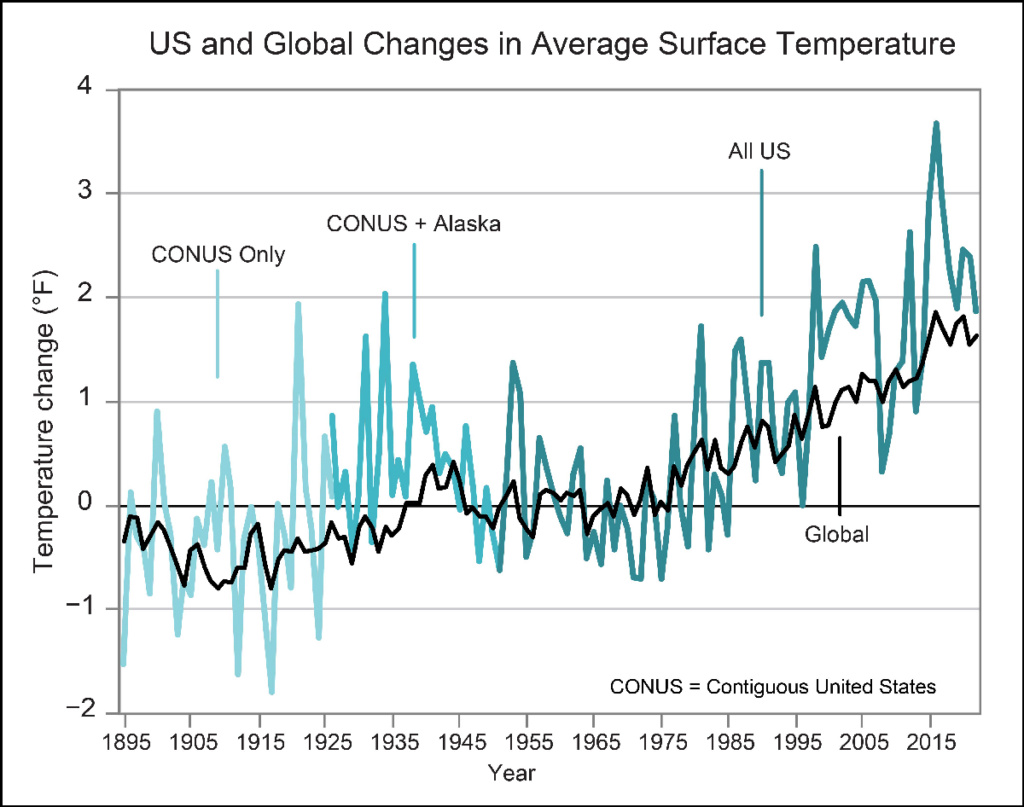Today, scientists released the Fifth National Climate Assessment detailing the effects of climate change in the United States. The report stressed that emissions-slashing efforts are struggling to keep pace with rapidly worsening climate risks.
There is some good news: Though the U.S. population has grown in the past 2 decades, emissions have fallen from their peak in 2007. But the decrease hasn’t been enough to prevent some of the worst impacts of climate change from affecting Americans, according to the report’s authors.
“We have an opportunity still to make choices that will lead to better outcomes.”
“We’re seeing broad-scale impacts of climate change on many different types of ecosystems and many human activities across the board,” said Kathy Mills, lead author of the oceans chapter of the assessment and an ecologist at the Gulf of Maine Research Institute. “We have an opportunity still to make choices that will lead to better outcomes.”
The Fourth National Climate Assessment, released in 2018, gave a detailed overview of the economic damage the United States faces due to climate change. This year’s assessment was originally planned for release in 2022 but was delayed by the Trump administration’s efforts to halt work on the report.
This year’s assessment emphasizes the need for more measures to cut global greenhouse gas emissions or remove greenhouse gases from the atmosphere. The report includes more detail on mitigation efforts already underway and highlights that all emissions (and mitigation efforts) matter.
“Each increment of warming that the world avoids—through actions that cut emissions or remove carbon dioxide (CO2) from the atmosphere—reduces the risks and harmful impacts of climate change,” the authors wrote.
The new report places greater emphasis on climate justice and environmental justice issues than previous assessments. It’s also the first climate assessment to feature collaborations with visual artists, with the understanding that “together, art and science move people to greater understanding and action.”
Earth Systems out of Sync
The assessment warns that climate change is impairing many natural processes and damaging ecosystems. Increasingly volatile weather, especially more extreme precipitation and drought, is causing challenges for farmers in particular, affecting agricultural production and reducing the accessibility and affordability of nutritious food, said Carl Bolster, the lead author of the report’s agriculture chapter and a hydrologist at the U.S. Department of Agriculture’s Agricultural Research Service.
“The pace of our attempt to adapt is often not matching the scale of the challenge.”
Just one extreme event can disrupt a farm’s entire annual cycle, making recovery difficult. “Adaptation and mitigation strategies can help, but the unpredictability of some of these events will be increasing, causing strain to the entire agricultural sector,” Michael Cosh, an author for the agriculture chapter and a hydrologist at the U.S. Department of Agriculture’s Agricultural Research Service, wrote in an email.
Climate change also heightens the risk that extreme weather and other natural hazards will combine to form compound events—when multiple climate hazards occur simultaneously or consecutively in one place. Responding to such events can be extremely difficult for communities, underscoring the need for better infrastructure, planning, and disaster preparedness, the authors report.
For example, Hurricane Henri and Hurricane Ida, back-to-back storms that struck the Northeast in 2021, resulted in 55 deaths and more than $21 billion in damages. The compound event was about 30 times more damaging and deadly than Hurricane Henri would have been alone, according to the report.

“The things we knew 5 years ago were going to be risks are here. We’ve seen it in all of the recent extreme events: wildfires, heat waves, flash floods. Every region of the U.S. is having some version of this,” said Pamela McElwee, the lead author of the report’s chapter on ecosystems and an environmental scientist at Rutgers University. “The pace of our attempt to adapt is often not matching the scale of the challenge.”
Marine and terrestrial ecosystems have felt the effects acutely. In the oceans, marine heat waves, sea ice loss, ocean acidification, and a loss of oxygen have all advanced at an unprecedented pace. These changes, Mills said, are a result of the ocean’s climate change buffering capacity—the ocean absorbs much of the heat that greenhouse gases have trapped in the atmosphere. But that can’t go on forever, she said. “As that slows down and we start accumulating more heat in the atmosphere, there will be dramatic impacts of that as well.”
Warming oceans have caused marine species to move to deeper waters or cooler latitudes, changing species distributions and pushing some animals into areas of the ocean where they threaten other species. Many fishing communities, especially Indigenous communities, are beginning to suffer because of changes in fisheries. “These changes threaten to break vital social and cultural connections by undermining food security and the mental and physical health and well-being of marine resource users,” the authors wrote.

Changes to terrestrial ecosystems have taken many forms: Some have received increased damage from more frequent natural hazards, whereas others suffer from more prevalent diseases and invasive species. As the planet warms, these risks are expected to increase, the authors wrote.
Many of these threatened ecosystems protect human communities. Coastal wetlands, for example, shield coastal communities from sea level rise and hurricanes.
“Think about all the things that we rely on nature to provide for us: the soil that enables us to grow food, the water that we drink, or clean air. These are all increasingly at risk because of climate change,” McElwee said. The breakdown of such important ecological processes will have consequences for human health and well-being, she explained.
Halting Climate Change
The report is clear that it’s too late for humanity to avoid many of the hazards caused by climate change. But every reduction in greenhouse gas emissions reduces climate impacts and provides immediate health and economic benefits. The United States has committed, under the Paris Agreement, to slash greenhouse gas emissions 50% by 2030 but will need to accelerate action to meet that goal, according to the assessment.
Climate action has increased in every part of the country, with the total number of state-level mitigation activities up 83% since 2018. Recent improvements in wind power, solar power, and battery storage technologies are one reason for optimism, said Steven Davis, the lead author of the report’s mitigation chapter and an Earth system scientist at the University of California, Irvine.Wind and solar energy costs have dropped by 70% and 90%, respectively, making the technologies even more feasible for communities to implement.
“We actually have more affordable options for cutting emissions than we ever have,” Davis said. Last year’s Inflation Reduction Act was a “huge win” to advance mitigation efforts and improve affordability, he added.
The assessment authors wrote that many mitigation measures also have secondary benefits for human health, particularly by reducing air pollution. “If we’re successful in mitigating greenhouse gas emissions, we often will see disproportionate benefits to vulnerable populations,” Davis said.
Although improvements are happening, one sector has been stubbornly hard to decarbonize: agriculture. Artificial fertilizers, needed for nearly every industrial crop grown in the United States, release nitrous oxide—a greenhouse gas with 265 times the warming impact of carbon dioxide. And livestock release huge amounts of methane, another greenhouse gas.
To meet international climate goals, mitigation efforts will need to intensify. That could mean a rapid phaseout of coal-fired power plants, more investment into carbon dioxide removal, and a rapid decarbonization of aviation and long-distance freight transport, according to the report.
Adapting Equitably
As mitigation efforts improve, communities and governments have also started taking advantage of adaptation strategies. For example, the report notes an increase in nature-based solutions, such as coastline restoration and urban tree planting, to reduce climate hazards to communities. More governments have invested in infrastructure upgrades to deal with climate risks as well.
But this increase in adaptation efforts is “insufficient” in comparison to the rate of climate change. The report states that adaptation has been incremental and done at small scales. A total of 32 states lack a public adaptation plan, and states with adaptation plans have been slow to implement them.
“We are making some really exciting progress.”
The authors stressed the need for centering justice and equity concerns in adaptation plans. Social systems have created an unequal distribution of both the benefits of mitigation and adaptation and the hazardous impacts of climate change, according to the report. In particular, climate change disproportionately harms Black people, Indigenous people, and People of Color, as well as low-income communities, rural communities, women and gender minorities, and other overburdened communities.
This unequal distribution of benefit and harm means that organizations implementing adaptation and mitigation efforts must pay special attention to who will receive the benefits of those efforts. Overburdened communities must be able to meaningfully participate in climate policy decisionmaking to advance environmental justice, the report stresses.
Although the report highlights countless successful adaptation, mitigation, and justice efforts, much remains to be done. But, Davis said, the tools and technology needed to reduce climate risks exist—they just need to be implemented. “We are making some really exciting progress.”
—Grace van Deelen (@GVD__), Staff Writer

